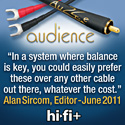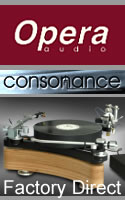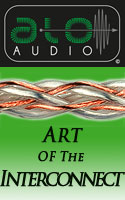|
|
You are reading the older HTML site
Positive Feedback
ISSUE
58
rogersound labs Compression Guide (CG) Stereo System - A Second Look as reviewed by Steven Lefkowicz
Back in the early 1980s, when I was new to California, I lived a few blocks away from a Rogersound Labs store in the San Fernando Valley. I stopped in several times to look at what they had to offer. Mostly they had mid-fi electronics, i.e. the typical receivers, turntables and stuff that other big stereo shops used to carry. However, they had their own line of speakers, many looked very similar to various models from JBL, but at very reasonable prices. Since it was about the time I was moving from my college dorm system, to my first "high end" system, it wasn't really what I was looking for. Can't say I thought much about RogerSound Labs since then. Imagine my surprise when, as I roamed the halls at T.H.E Show in Newport, I ran across a door sign that said "Rogersound Labs" and inside was Howard Rogers himself! The speakers on display, however looked nothing like what I remember from the old RSL lineup. Small satellites with a fairly large looking subwoofer did a pretty respectable job of filling the hotel room with music and showed a lot of promise. I requested a review pair right away. It wasn't until I followed up weeks later that I found that a set had already been sent to fellow PFO scribe Michael Wechsberg (read that review here). Knowing that Michael comes from a much more upscale approach to his system than I do, I felt a second opinion would be in order. Since Michael gave a thorough description of the design, construction and feature set of the RSL CG System, I'll direct you to his review in issue 56 for those details. I'll just stick to my listening impressions and opinions of how well these suit my decidedly budget minded outlook on audio. The speakers were used with the same gear listed in my last review, which included vintage PS Audio 4H preamp, Adcom 535 and Antique Sound Labs AV-8 Wave amplifiers, Marantz SA-8001 SACD player. Interconnects were all Nordost Solar Wind, and speaker cables were mostly Radio Shack 14-Gauge Flat Megacable® Wire, terminated in banana plugs, with occasional use of either Nordost Flatline or Solar Wind cables, as well as some "high resolution speaker wire" supplied by Rogersound Lab. This appeared to be basic 12 gauge copper twin lead wiring, which RSL sells for $50 per 50-foot spool.
Knowing that the speakers were all broken in already, I was able to start serious listening right away, knowing that my first impressions would be fairly valid, at least for the major characteristics. Of course the biggest, most time consuming part of this was setting up the subwoofer for optimum use. Unlike the small Hsu sub I last reviewed, the RSL Speedwoofer 10 is much bigger, heavier and specified down to a wall shaking 24Hz. Although I wanted to try numerous positions within the room, the need to run interconnects from the preamp to the sub, and then more interconnects from the sub to the main power amp (in order to use the remote control for the crossover), limited my choices. Fortunately, of the positions I tried, the Speedwoofer 10 worked best when positioned in the same place as the Hsu sub, which was within a couple feet of my equipment rack. It was the same with the small satellites. I tried them on the stands in the same place where the Hsu HB-1 sounded best, and after moving them about for a few days, decided that the original location worked best. This had me sitting about eleven feet from them, with about 12 feet between them. One really nice thing about the system is the remote control for the subwoofer, which allows for both crossover point and level to be adjusted from the listening position. Though I suppose some purists would say you should set it for proper flat response, and then leave it alone, I found it nice to be able to adjust for individual CDs to get the most natural sound. Of course the better the recording, the less I adjusted things. Overall, I was very impressed the RSL system. Music of all types was consistently portrayed in a very energetic, exciting and dynamic fashion. I still have an expectation that as speaker cabinets and driver sizes get smaller, that the dynamic presentation they deliver will be restricted as compared to larger systems. Yet, though being the smallest speaker I had in house, and one of the smallest speakers I've ever reviewed, they were substantially more dynamic than any moderately priced speakers I've listened to in recent years. According to Howard Rogers, that vibrant, dynamic presentation is one of the primary characteristics of their "Compression Guide" tuning. It was nice that they were able to produce a big, dynamic sound without being too demanding of amplifier power. I mostly used the Adcom GFA 535, which is rated at 60 watts. There was never any sense of strain or indication that the amp was running out of power. On the other hand, a brief attempt at listening with the eight watt Antique Sound Labs AV-8 Wave amps, which worked quite nicely with the Hsu HB-1 speakers, wasn't so successful. The sound thinned out and the amps indicated clear signs of strain at anything approaching moderate to normal listening levels. That isn't really an issue or a complaint, as the little ASL amps really need an easy to drive, fairly efficient speaker. You really can't expect too much from a $99 tube amp. Of course, dynamics are only one part of musical reproduction. Tonally, the speakers were quite nice, with a hint of a little extra energy in the mid to high frequencies. This is not something I would necessarily call bright, but it was reminiscent of the small, much more expensive Totem Mites that I reviewed (very positively) many years ago. The tonality gave most music a sense of excitement and energy that was generally very appealing. The Speedwoofer 10 was definitely a powerhouse, digging down deep to the limits of what my room could support. I measured pretty strong response down into the mid 20Hz range, with a slight rise at 25Hz that I couldn't reduce without leaving a noticeable incongruity between the sub and the satellites. This was purely result of the interaction of my room, and anyone setting up a powerful sub will have to deal with room interactions and adjust accordingly. By allowing for a small rise in the very deep bass, I was able to get a very smooth transition between the speakers and sub. With the small frontal surface of the speakers, I expected good imaging and pinpoint placement, and that was what I heard. Having used the Direct Acoustics Silent Speakers for a few years, with their extravagantly large, room filling soundstage, but without precise specific individual image placement, the difference between the two systems was huge. I think traditional audiophiles will prefer the RSL's pinpoint image placement, while those who tend more towards the "music lover" side of things might go for the Direct Acoustics type are large, natural sounding soundstage. Both speakers certainly disappear, allowing the music, in one form or another, to fill the room. You decide which presentation you prefer. Over several weeks I played a wide variety of music, old favorites and new discoveries. I listened to many of the thirty-three CDs I have from Moonjune Records in preparation for a large scale review of that label's output. In spite of the complex, and sometimes challenging musical content of many of those CDs, I found myself able to concentrate totally on the music, while not being sidetracked with what was happening with the system in general or the speakers in particular. When you spend a large amount of time listening for sound in the context of equipment reviews, finding a system that lets you put that aside and just listen to the music is a treat and a relief. The flow, pace and rhythm of music, the level of detail presented, and the ability to make it easy to hear what each instrument was doing in the mix was essential for digesting the progressive jazz and rock from bands like D.F.A, Marbin, Tohpati Ethnomission, Moraine and Iron Kim Style. Ultimately, we have to consider that at $1250 for the set, there is a lot of competition for quality speakers. Surely there will be few that can compete in terms of full range response, though of course others that use larger sized subwoofers might. Certainly the Speedwoofer 10 is an excellent subwoofer, with tremendous depth and power capabilities, and the remote control is both highly useful and actually fun to play with. The CG4 monitors dynamic capabilities, detail overall tonal balance and imaging quality make the overall system highly competitive and certainly recommended. Steven Lefkowicz
RSL CG Stereo System
RSL Speaker Systems
|







